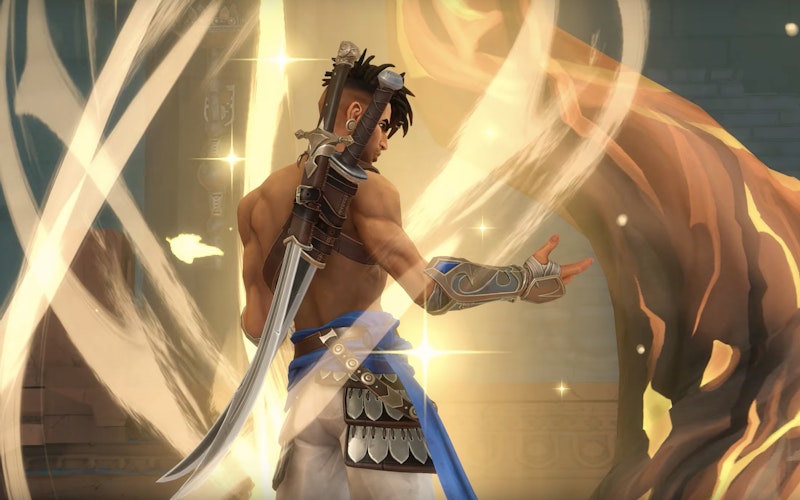
Games
Saving Time in Prince of Persia: The Lost Crown
Time can feel like a curse, with the past and the future both pressing in on the present. Even as believers in the eternal God, we struggle to know how to live in the time given to us. Prince of Persia: The Lost Crown considers this very same dilemma, in a world where time actually is cursed.
Sargon, the game’s protagonist, travels to Mount Qaf along with fellow Persian warriors. One of their own has kidnapped their prince for an unknown purpose, so the warriors split up to find the traitor. Even greater distrust and betrayal follows, however, because “fragments of past and future . . . swirl like grains of sand in a violent storm,” as one character explains. Some warriors recall encountering alternative versions of Sargon, who come from the future. (Or past?) As you play The Lost Crown, you’ll meet these doppelgangers, who attempt to steal your powers. “Time no longer flows like a river,” one of them says. “It’s a raging sea where all fates are intertwined.”
This line paraphrases a recurring quote throughout the Prince of Persia games, which have been rebooted multiple times. In this universe, timelines overlap, diverge, and begin anew. Prince of Persia: The Forgotten Sands, from 2010, even features four unique stories and gameplay styles across platforms, despite all sharing the same name. “At the beginning of the curse timelines shifted often,” an elderly mage says in The Lost Crown. The whole of the franchise is marked as well. Yet this is partly what makes Prince of Persia special, with its malleable universe and game design. In The Lost Crown, time’s curse arguably blesses Sargon. By encountering his alter egos and different timelines, his own temporal trajectory becomes clearer. Sargon learns how to relate to time in order to heal it.
As Sargon, the player gently manipulates time by rewinding or fast-forwarding to a spot where he was (or will) be. Even his double-jump is visually portrayed as a reset to jump once again rather than twice. Your immediate past and future influence how you solve puzzles and defeat enemies. In The Lost Crown’s massive world, I’d leave an echo of Sargon before exploring an unbeaten path. If I didn’t like where it led, I’d time travel back to the echo. What would otherwise be dead ends, fatal falls, and impossible leaps can be solved by manipulating time. Still, the world will remember your progress. The player and Sargon remember. “Events start again. While YOU continue,” a goddess tells Sargon. He replies, “I have memories of how things were and how they could be.”
Sargon learns how to relate to time in order to heal it.
Theological philosopher James K.A. Smith elaborates on the complexity of time in How to Inhabit Time. Past, present, and future are not neat categories, according to Smith, nor a hierarchy where one is better than the other by default. Our timelines and history books can belie time’s vagaries and mysteries. The past and future stretch into the present, contributing to what Smith calls “contingency,” which is the experience of wondering what “might not have been, doesn't have to be, and could have been otherwise.” However, this is reined in by “thrown possibility,” which describes how possibilities for our lives aren’t endless, but constrained by who we are, where we come from, and when we are. In other words, our social location directs our fate, yet “is not a limitation as much as a focusing, a gifted speciality.” This lends clarity to a scene where Sargon asks his god, the Simurgh, about being chosen over his alter egos. “Which others?” the Simurgh replies. “They exist only in your eyes. I only see one man before me.”
Whereas Sargon sees the “thrown possibilities” in his various versions as flaws to excise, the Simurgh says, “All are your allies. All are fragments of a future sun.” The Simurgh doesn’t erase who Sargon was or hide what he could be. His flaws point to his potential—his greatest path. In How to Inhabit Time, Smith believes this is how God works, with “a promise of restoration attuned to [our] history.” Only God “could make even [our] vices the soil in which he could grow virtue.”
Indeed, any time Sargon dies, the Simurgh briefly appears in the backdrop before Sargon disappears in a burst of light, waking up at his last checkpoint. This isn't depicting an act to rewind to the past, it is—as Smith says to describe liturgy—“a repetition forward, a return that generates new possibilities” in a sort of time that’s “cyclical and linear.” The Simurgh intervenes to keep Sargon on his path, representing his (and the player's) mistakes and failures as part of his history.
Playing as Sargon, you eventually realize that saving time means accepting your finitude in the face of it. Humans are inextricably in and of time. This doesn’t mean life is a rigged game with the divine puppeteering your fate; rather, the divine extends an open palm in a spirit of collaboration and guidance. The teacher in Ecclesiastes, who meditated beautifully on this topic, encouraged us to flow with the current of time, not against it. This way, we will see how our fortunes and misfortunes are woven into God’s story, telling the full tale of what can only happen in God’s time: Change. Redemption. Restoration.
Topics: Games